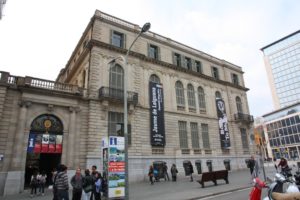

Palau, which in Catalan means “palace”, is a commonly, and often times, figuratively used term throughout Barcelona, such as the Palau de la Música Catalana; not an actual or former palace, but nonetheless, a magnificent work of art.
Palau Robert is an actual palace where the Robert i Surís family used to reside back in the early 1900s, and was later used as the Generalitat de Catalunya’s Ministry of Culture during the Spanish Civil War in the 1930s. In 1981 the Generalitat de Catalunya bought the building, the garden and annexes, and now functions as the Catalan Center for Information.
Table of Contents


Passeig de Gracia and La Rambla were once a haven for Modernisme architects such as Domènech i Montaner, Puig i Cadafalch and of course, Anton Gaudí.
You can take a tour of Palau Robert from Monday to Saturday: 10 am to 8 pm, and on Sundays and holidays from 10 am to 2.30 pm.
There are four different rooms where the Catalan government displays exhibitions that change every season. The most recent exhibition that just ended October 25th was the “Catalunya Moto“, which captured the motorcycle world over the past 50 years, a world that thrives in Barcelona, focusing on the following four themes: Industry, Society, Competition and Technology.
The most current exhibition “Nature Paths: Vital Itineraries” focuses on sustainable living and celebrates the 40th anniversary of the first nature path in Catalonia and in Spain, in Santiga Wood, Barberà del Vallès.
My personal favorite part of the Palau is the garden, which holds an incredibly diverse range of flora and fauna, different types of trees from all over, famous sculptures, artwork, and of course, pristine architecture surrounding the paths of the gardens. In the summer, the gardens function as a dreamlike concert venue and have shows throughout the warmest of months in the city.
You can get to this Catalan landmark by taking the metro to Diagonal green L3 & blue L5. You can also get there by bus, taking any of the following lines: 6, 7, 15, 16, 17, 22, 24, 28, 33, 34. If you are coming in from out of the city, the nearest FGC train station is Provenca, and you can take either L6 or L7 from there.
Barcelona’s Mediterranean climate, with increasingly warmer and longer summers, makes air conditioning an essential feature…
Maybe you're thinking about selling a property or you've just inherited one or more real…
Do you enjoy strolling among trees and plants, away from the hustle and bustle of…
If you are planning to move to Barcelona for a few months or permanently, one…
ShBarcelona establishes itself as the leading agency within the Apialia Eixample Group, reaffirming its position…
Are you going to visit Barcelona this 2025? The vibrant Catalan capital once again becomes…